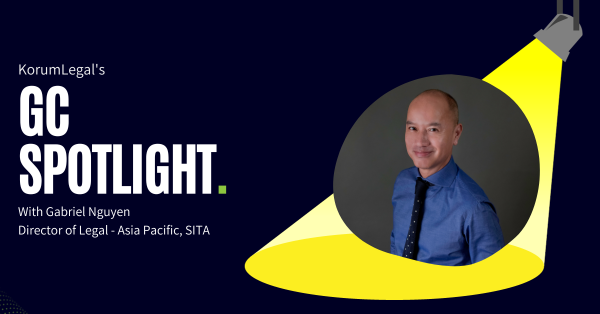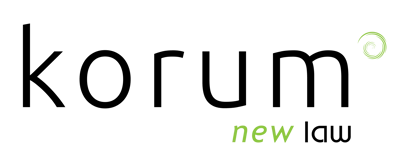GC Spotlight: Gabriel Nguyen on the future of legal services..

This month we have Gabriel Nguyen under the spotlight. He is the Director of Legal - Asia Pacific at SITA. He started his career in oil and gas in Europe and has since moved to the IT/technology industry in Asia. Let’s find out in this Q&A what keeps him awake at night, his views on LegalTech/ALSPs and why he thinks space exploration will always intertwine with romance!.
1. Hi Gabriel, can you tell us a little about your role and journey into law? What excites you outside of work?
Thank you for having me. I head the legal department of SITA Asia Pacific. SITA is the world's leading specialist in air transport communications and information technology. We are present in over 1000 airports in over 200 countries. Our solutions ensure seamless air travel for passengers. When you fly out for work or vacation, more likely than not, you are using SITA’s services from the moment you check in for your flight until the time you collect your luggage at the other end of your trip. With my other 3 esteemed legal colleagues in Singapore, we ensure that SITA Asia Pacific achieves its business objectives, with our airlines, airports and government customers in a legally compliant manner and with acceptable levels of risk. SITA Legal is a partner to our business colleagues and we pride ourselves in not only anticipating and identifying legal issues but also devising strategies to solve them. Before joining SITA Singapore I held several roles with SITA in Europe. In a previous life I was in the oil and gas industry with Schlumberger where I provided legal support to their oilfield activities in Continental Europe, the North Sea and Africa.
In my spare time, I hone my skills as a jazz pianist (this could be my next career switch!) and most weekends you will find me windsurfing on the East Coast of Singapore. There are some similarities between windsurfing and in-house lawyering in that often you are not fully in control of the environment but you need to finds ways to navigate the ocean of uncertainties so that you can reach your target destination. As per a famous quote “I can’t control the wind but I can adjust the sail”.
2. As a Head of Legal, what are some of the challenges that keep you up at night? How are you addressing them?
Zooming in: keeping my team motivated and engaged is at the top of my mind. In subtle ways Covid 19 and the WFH practices have impacted the corporate fabric. Whether we like it or not, the hybrid working model is here to stay and the way we relate to work has evolved. At SITA the policy is 3 days in the office and 2 days WFH. As a leader, I face the challenge of having to maintain the high level of productivity of the legal team while making sure that my team members are mentally in a safe place and also – yes – happy to be part of the team. My active listening and support to my team members to enable them to successfully perform their duties became more important than ever.
Zooming out: Asia Pacific is a combination of multiple jurisdictions with different legal systems at different stages of maturity with constant developments. The “horizon scanning” is a priority for my team to ensure that SITA is prepared and takes steps to comply with any new legal or regulatory norms which could affect the way SITA runs its business in Asia Pacific. Furthermore, we want the legal compliance framework to provide a competitive edge to SITA over our competition. I am referencing for example the analysis that we had to do on implications for SITA of the rules applicable to Critical Information Infrastructure owners in Singapore in the space of cybersecurity and similarly for the Chinese Standard Contractual Clauses for cross-border personal data transfer which will fully take effect on 30 November 2023, to name a few.
3. What do you think about the use of LegalTech, data analytics and process optimisation to improve your legal department's value?
In today’s world legal departments have to show value on par with other corporate functions. Gone are the days when in-house lawyers can point to their “specialness” to avoid having to demonstrate their contribution to the bottom line of the company beyond the pure provision of legal advice. I can think of a few ways LegalTech, data analytics and process optimisation can improve SITA legal department's value:
- Increased efficiency: LegalTech can help with automation of routine and low level work and thus free up time for our lawyers to focus on more complex and strategic matters. For a long time we tried to remove the SITA lawyers from the review of Non-Disclosure Agreements (NDAs) and to have the business teams use our standard SITA NDAs with third parties. The take up rate was low as the NDAs in Word document format somehow always found their ways back to Legal for processing. Recently we have put in place an automated on-line tool for the issuance of NDAs and it has drastically reduced the need for our lawyers to be involved with the NDAs. The business colleagues could go on-line, fill in a few fields and an NDA would be sent automatically to the third parties for their DocuSign. No more paper printing which is also good for the Planet. Next, we are currently assessing an AI Pre-signature tool to enhance the review of our commercial contracts, risk assessment and support to contract negotiation. Automation and use of templates with a set process will also ensure that all the steps of the process are carried out consistently. This will reduce the risk of errors and improve the quality of the legal end products.
- Provision of data points: data analytics will allow SITA to track and measure the performance of the legal department through KPIs. It will also give us greater granularity in the analysis of the files which go through our department and enable us to identify trends e.g time spent on certain types of matters, and emergence of new contractual risks.
- Costs savings: automation will relieve the workload of my valuable colleagues and allow them to concentrate on the work which would otherwise be outsourced to outside counsel at a cost. Legal research is also an area that LegalTech can help us with. Legal applications which allow in-house counsel to find the first level of legal information quickly and accurately without having to resort to outside counsel for that initial advice.
4. What trends do you expect to see in the legal services industry in the next 5 years?
In my opinion, we can expect a further rise of Alternative Legal Service Providers (ALSPs) in the ecosystem of legal services. The strength of the ALSPs lies in their leverage of technology to offer products and services which set them apart from the offerings of law firms. With the rise of ALSPs, legal departments will see more options to solve their needs be it from the cost optimization or solutioning aspects. There will be cooperation between law firms and ASLPs when combining their areas of expertise to bring benefits to their clients. The market of legal services will see renewed competition with new entrants such as the Big Four. Big Law will have to innovate to stay relevant. This dynamic environment will be a positive development for the legal community.
I mentioned above how automation and AI have helped SITA in the management of our contracts and the surrounding processes. In the next 5 years we can guess there will be an increase in the array of technology-enabled tools whose aim is to optimize efficiencies and reduce costs.
Lastly, we can hope the use of technology will allow law firms to be creative in their billing so that we can move away from the hourly billing system.
5. Where do you see NewLaw/ALSP fitting in the matrix of your legal department?
I welcome the fact that NewLaw/ALSPs give me more options to address the various people/secondment needs of my department such as set up a maternity cover, arrange extra resources to cater for an overflow of work or supercharge my team with a short term specific legal expertise for a project. As to the technology part, I must admit I am still to explore the breadth of the technology solutions offered by NewLaw/ASLPs.
6. Your favourite tune? And why?
It’s difficult to pick just one! “Fly Me to the Moon” would be a good candidate. It’s an evergreen song about love and the universe. Written more than half a century ago, the tune is still very relevant today as romance is perennial and space exploration is a perpetual quest of mankind.
Lily Evans and Gabriel Nguyen
Sep 25, 2023
Related Posts.
By: Lily Evans and Christian Greissinger
GC Spotlight: Christian Greissinger how LegalTech
Featured in our GC Spotlight Series this month is Christian Greissinger who is the General Counsel ASEAN Australia for Siemens.
Christian started his career at the international law firm Lovells..
By: Lily Evans and Chris Ford
LegalTech Soapbox: Strengthen your daily operations with Legalyze.ai
1. Hi Chris, tell us the story behind Legalyze.ai
Legalyze.ai was created in partnership with a litigation practice. The practice was in the middle of a trial with lots of documents, and Legalyze.ai..
